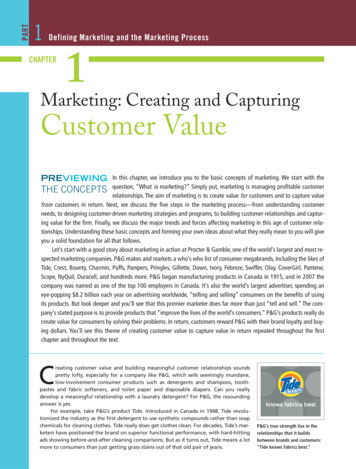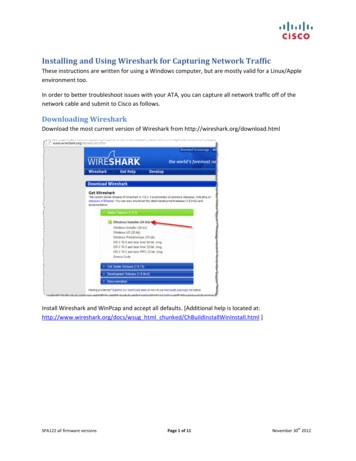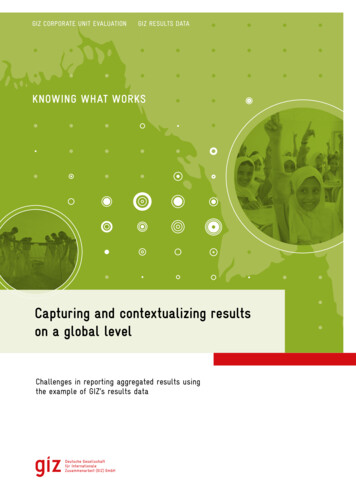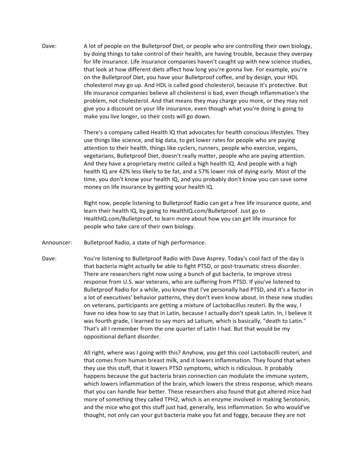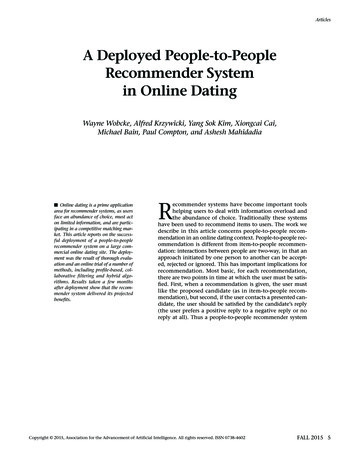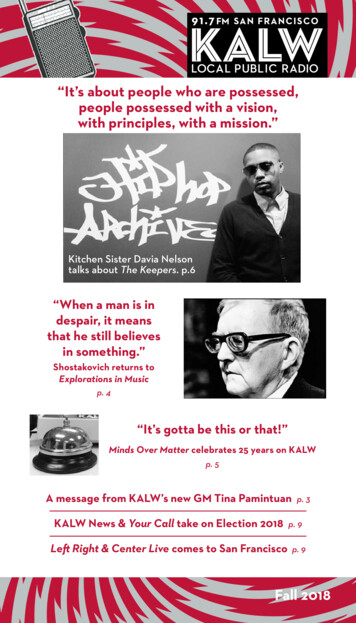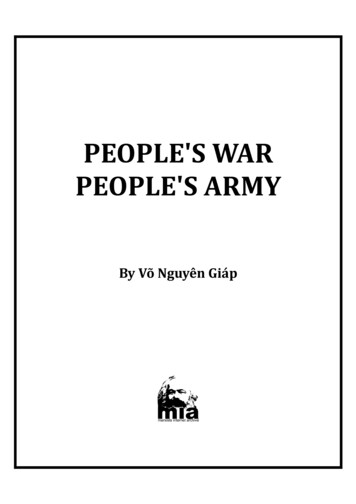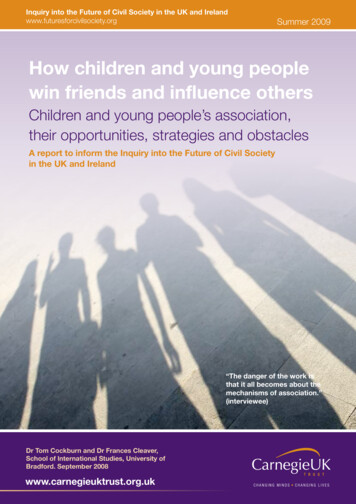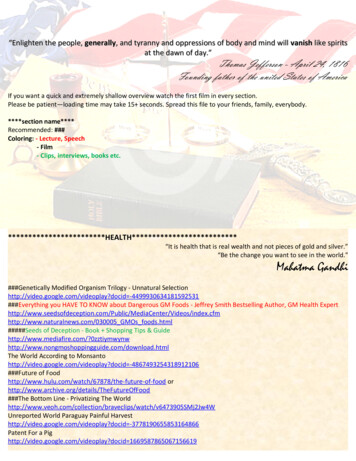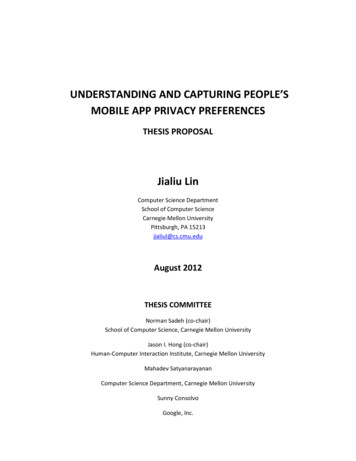
Transcription
UNDERSTANDING AND CAPTURING PEOPLE’SMOBILE APP PRIVACY PREFERENCESTHESIS PROPOSALJialiu LinComputer Science DepartmentSchool of Computer ScienceCarnegie Mellon UniversityPittsburgh, PA 15213jialiul@cs.cmu.eduAugust 2012THESIS COMMITTEENorman Sadeh (co-chair)School of Computer Science, Carnegie Mellon UniversityJason I. Hong (co-chair)Human-Computer Interaction Institute, Carnegie Mellon UniversityMahadev SatyanarayananComputer Science Department, Carnegie Mellon UniversitySunny ConsolvoGoogle, Inc.
ABSTRACTA number of ongoing research efforts focus on protecting mobile users’ privacy and security,using software analysis techniques or security extensions with app-specific privacy controls.These proposed extensions might overwhelm users with unnecessary and difficult to understanddetails. Unfortunately, there has been little work done to understand users’ privacy preferencesregarding mobile apps. A key question is whether it is possible to identify how apps' privacyrelated behaviors impact users' privacy preferences in order to simplify the decisions users haveto make without reducing their level of control over the decisions they really care about.The proposed dissertation work aims to help answer this question. Specifically, we propose touse crowdsourcing and user-oriented machine learning techniques to capture and quantitativelymodel users' privacy preferences regarding mobile apps. We will perform detailed static analysison a representative set of apps on the Android platform to understand their private resourceusages. We will also use crowdsourcing to collect users' perceptions of these apps, includingtheir expectations and levels of comfort in using these apps. The idea is to identify a relativelysmall number of sensitive data usage scenarios that most significantly impact users’ privacydecisions when using a particular mobile app. By performing clustering, we expect to isolatedifferent classes of mobile apps that elicit common privacy concerns and different groups ofusers with distinct privacy preferences. Based on these clusters, we want to see if we canidentify a small number of user-understandable privacy profiles (or “personas”) that can be usedto simplify the privacy settings users could be exposed to.The findings of this thesis can offer insight into improving current mobile privacy interfaces andsettings. As a by-product, our resulting models and findings could also help mobile appdevelopers estimate the user acceptance of their apps from a privacy perspective.2
1 INTRODUCTIONSmartphone ownership has grown rapidly over the last few years. In 2012, global smartphoneshipments are expected to reach 614 million units [27]. Nearly half of cell phone owners carrysmartphone nowadays. The explosion in smartphone ownership has been accompanied by theemergence of App Stores that enable users to download a growing number of applications ontotheir devices. As of June 2012, the Google Play Store1 offered more than 600,000 apps, withmore than 20 billion downloads since its inception; the Apple App store offered more than650,000 apps with more than 30 billion downloads since its launch. Mobile apps can make useof numerous capabilities of a smartphone, such as a user’s current location and call logs,providing users with pertinent services and attractive features.Inevitably, access to these capabilities opens the door to new types of security and privacyintrusions. Malware is an obvious problem [18, 36]; another serious problem is that mobileusers, in general, are neither fully aware of nor have full control over how mobile apps accessand transmit personal information. For example, the Pandora music app is under federalinvestigation for gathering location data, gender, year of birth, and unique device ID frommobile users and sharing this information with advertisers [19]. Social network applications,such as Facebook and Path, were found uploading entire contact lists onto their servers, whichgreatly surprised users and made them feel very uncomfortable [44, 76]. In fact, studies [38, 57,59] have shown that users have a poor understanding of these sensitive resource usages, andexisting interfaces fall short in terms of providing users with the information necessary to makeinformed decisions.A number of ongoing research efforts focus on protecting mobile users’ privacy and securityusing software analysis techniques or security extensions with app-specific privacy controls.(e.g., [15, 49, 87]). However, these proposed privacy controls were not grounded in userresearch. Asking users to systematically configure all these settings is unrealistic as it canoverwhelm users with details they struggle to understand and may ultimately not care about. Todate, not much work has been done to understand people’s privacy preferences in using mobileapps and see to what extent a better understanding of these preferences could inform thedesign of interfaces that empower users to better manage their privacy.The fundamental goal of this thesis is to complement existing mobile privacy research byproviding important knowledge on the end-users' side. A key research question we aim to solvein this thesis is whether it is possible to simplify decisions users have to make without reducingtheir level of control over the decisions they really care about. Specifically, we propose to usecrowdsourcing and user-oriented machine learning techniques to see whether it is possible toreduce and simplify the number of privacy decisions exposed to users without negativelyimpacting their sense of control. The idea is to identify a relatively small number of sensitivedata usage scenarios that most significantly impact users’ privacy concerns when using aparticular mobile app. By performing clustering, we expect to isolate different classes of mobile1Previously called “the Android Market.”3
Figure 1. This figure illustrate where this thesis posit in the mobile privacy research. My proposedwork complements existing mobile privacy research by providing important knowledge on the userside. My past work and the formative study are also marked in this figure, which will also becovered in this proposal.apps and different groups of users with distinct characteristics. A small number of userunderstandable privacy profiles (or “personas”) will be learned based on the clusters of userswith similar preferences.Our previous work used location-sharing services as a prominent example to investigate users’privacy preferences in context sharing. We found that even when considering only this type ofprivate resource, users' privacy preferences were complex and varied regarding a number offactors, which ranged from motivation and context to cultural influences. Yet, by leveragingmachine learning techniques, we were able to identify certain patterns in users’ privacypreferences and to some extent predict users’ sharing behaviors under different context. Thisthesis will extend the discussion to general mobile apps other than context sharing services, inwhich users' personal information is not only shared with the members of their social networkbut also with app developers or 3rd parties. We foresee that this discussion will involve asignificantly more complex problem space. Figure 1 shows where this thesis fits into the domainof mobile privacy research. We will conduct in-depth quantitative analysis on users' mobile appprivacy preferences, especially how users' levels of comfort vary with different private resourceusages.More specially, my thesis will attempt to answer the following questions:1. How can we capture users’ mobile app privacy preferences in a scalable manner?2. What are the key factors that affect users’ privacy concerns about mobile apps?4
3. To what extent can we identify meaningful collections of mobile apps that elicit similarprivacy preferences among users?4. To what extent can we identify groups of users who share similar privacy preferencesfor different collections of apps?Given that there are more than half a million mobile apps in more than thirty categories, dozensof different private resources and presumably diverse privacy attitudes of users, conventionaluser study methods are not feasible for data collection due to their limited scalability and highmanagement and time cost. Our initial results showed that crowdsourcing can scale up the datacollection (i.e., capturing users' privacy preferences) in an efficient way [59]. Furthermore, initialresults also suggested that despite the variety of sensitive data and functionality accessed byapps, users’ privacy decisions are influenced by their expectations of these apps and thepurposes of the resource usages. As part of this thesis, we propose to explore the validity andramifications of these observations and leverage machine learning techniques to perform morein-depth analysis on both mobile apps’ privacy-related behaviors and users’ privacy preferences.We seek to determine to what extent different usage practices and groups of users could beidentified to simplify the design of privacy control settings.The central thesis aims at providing quantitative foundations and user perspectives to mobileprivacy research, which can be summarized as:By using crowdsourcing and user-oriented machine learning techniques, we canbuild accurate and understandable models of mobile apps and users’ privacypreferences to inform the design of mobile privacy interfaces and settings, and tohelp developers build more privacy preserving apps.This thesis will contribute to mobile app privacy research in several ways including: We will compile a valuable dataset that includes attributes to describe privacy-relatedbehaviors of mobile apps as well as how users feel about them though automated staticanalysis and crowdsourcing. This dataset will be an important foundation for allquantitative analyses in my thesis. It can also be used for other research purposes.We will develop detailed regression models of users' privacy preferences along withidentified features that most critically impact users' comfort in using these apps.We will cluster apps based on their sensitive resource usage patterns and the resultinglevel of comfort expressed by users, and will present the predictive model generalizedfrom these app clusters that could be used to estimate user acceptance of other apps.We will identify a set of default privacy settings by clustering users based on theirpreferences of different clusters of apps. Users can choose from these default settingswhen configuring their mobile app privacy settings. These default settings can greatlyreduce user burden compared to other privacy settings that require users to specifytheir preferences for individual apps.5
Collectively, these contributions should provide a scientific basis for starting to reconcile mobileprivacy and usability and, in particular, helping inform the design of more usable privacysettings.The remainder of this thesis proposal is organized as follows. In the next section, I willsummarize my previous work in location sharing as an initial exploration of users’ privacypreferences with a focus on how it links to the proposed thesis. Section 3 reviews currentmobile app privacy research and how our work differs from it. Section 4 provides thepreliminary results obtained from a formative study. Section 5 details the proposed work interms of the steps involved to conduct data collection and analysis in investigating users’ mobileapp privacy preferences. In the remaining sections, I clarify the scope of this thesis and present aproposed schedule for completing the thesis work.2 EXPLORING USERS’ PRIVACY PREFERENCES IN LOCATIONSHARINGOur initial exploration in users’ mobile privacy preferences started with location sharing,focusing on how to understand and resolve users' privacy concerns in using location sharingapplications (LSAs). These types of applications facilitate and encourage users to convey theirlocation information to others in users' communications, which have recently attracted interestfrom both industry and academia [2-8, 17, 50, 51, 71, 84]. With the proliferation of smartphoneownership, most location-sharing services are available on mobile platforms (e.g., GoogleLatitude [5], Foursquare [4], Facebook Places [3]). As a special subset of mobile apps, where theusers' location information is majorly consumed by people in their social networks,2 studying theprivacy issues in LSAs could provide important lessons from both methodological perspectiveand knowledge perspective.Some of my past work falls into this line of research [60, 61, 75]. Our findings indicated thateven only considering one type of sensitive resource, users' privacy preferences could be verycomplex and influenced by different factors. Our past work in location privacy provided us asound foundation to extend the discussion to mobile apps in general, helping us proceed to apresumably more complex area. In this section, I briefly discuss three studies I conducted in thisdomain, and show how this line of research links to the current thesis.2.1 Modeling People’s Place Naming Preferences in Location Sharing[61]In this work, we explored how users modulate their location information to cope with privacyconcerns by analyzing the place names they used to convey location within a location sharingsystem. Specifically, we wanted to identify the general patterns of users’ location namingpreferences in different contexts and determine to what extent preferences were predictable.2Though some location-sharing mobile apps also transmit users' location information to ad networks foradvertising purposes.6
To achieve this goal, we conducted a user study with 26 participants and captured their locationtraces and per-location sharing preferences by using the Day Reconstruction Method (DRM).Based on the data we collected, we proposed a taxonomy based on the underlying informationusers want to convey to organize the place label
The remainder of this thesis proposal is organized as follows. In the next section, I will summarize my previous work in location sharing as an initial exploration of users’ privacy preferences with a focus on how it links to the proposed thesis. Section 3 reviews current mobile app privacy research and how our work differs from it. Section 4 provides the preliminary results obtained from a .
